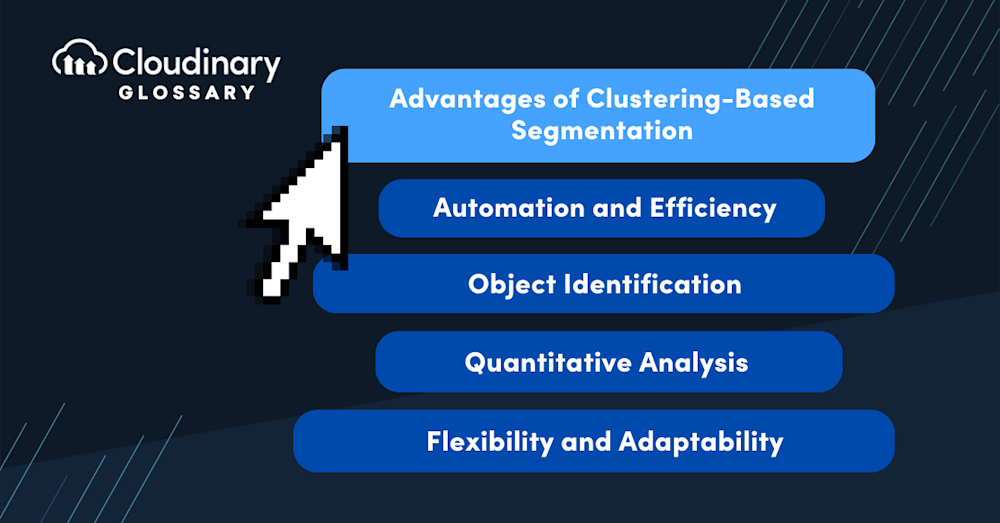What is Clustering-Based Segmentation?
Clustering-based segmentation is a method for segmenting images by grouping pixels based on their similarity or proximity. It relies on clustering algorithms, such as K-means or Mean Shift clustering, to partition the image into distinct regions with similar attributes. By assigning pixels to different clusters, Clustering-Based Segmentation allows for identifying and isolating objects or areas of interest within an image.
To make the concept more relatable, picture a scenic landscape photo. This photo comprises millions of pixels, each containing data about its color, brightness, texture, and more. Clustering-based segmentation in image analysis is akin to breaking down this landscape into distinct segments – for instance, the blue sky, the green trees, and the brown mountain range. Each of these segments can then be analyzed separately. This method is paramount to diverse realms such as medical image processing, remote sensing, computer vision, and object recognition, aiding in transforming complex data into understandable and workable segments.
Advantages of Clustering-Based Segmentation
Clustering-based segmentation offers several advantages over traditional manual or threshold-based segmentation:
- Automation and Efficiency – Clustering-based segmentation automates the image segmentation process, reducing the need for manual intervention. This increases efficiency, as large datasets can be processed quickly and consistently.
- Object Identification – By grouping similar pixels, Clustering-Based Segmentation enables the identification of objects or regions with similar attributes. This is particularly valuable in object recognition, image retrieval, and computer vision applications.
- Flexibility and Adaptability – Clustering-based segmentation is a flexible technique that can adapt to various images and objects. It can handle complex and variable backgrounds, making it suitable for diverse scenarios and applications.
- Quantitative Analysis – The segmented regions obtained through Clustering-Based Segmentation can be further analyzed quantitatively. This allows for extracting valuable insights and metrics from the image data, aiding decision-making processes.
Disadvantages of Clustering-Based Segmentation
While Clustering-Based Segmentation offers many benefits, there are also some limitations to consider:
- Sensitivity to Initialization – Clustering algorithms used in Clustering-Based Segmentation can be sensitive to initialization. Improper initialization of cluster centers may result in suboptimal segmentation results or convergence to local minima.
- Manual Parameter Tuning – Clustering algorithms often require manual tuning of parameters, such as the number of clusters or distance thresholds. This trial-and-error process can be time-consuming and require expertise to achieve optimal results.
- Over-Segmentation or Under-Segmentation – Clustering-based segmentation may suffer from over-segmentation (where objects are divided into minimal regions) or under-segmentation (where multiple objects are merged into a single area). Balancing these trade-offs can be challenging.
Use Case of Clustering-Based Segmentation
One prominent use case of Clustering-Based Segmentation is in medical image analysis, particularly in tumor detection and delineation. By leveraging clustering algorithms, medical images can be segmented to identify tumor regions. This enables accurate assessment, diagnosis, and tracking of tumor growth and response to treatment.
Clustering-based segmentation is also applied in content analysis for digital asset management. A comprehensive Digital Asset Management (DAM) solution like Cloudinary leverages segmentation techniques to automatically tag and categorize images based on their content. This facilitates efficient organization, search, and retrieval of images, enhancing workflow efficiency and content discoverability.
Final Thoughts
Clustering-based segmentation presents a powerful approach to automating image segmentation tasks and extracting valuable insights from image data. With its advantages of automation, object identification, flexibility, and quantitative analysis, Clustering-Based Segmentation has diverse applications in fields like medical image analysis and content management.
To leverage the potential of Clustering-Based Segmentation and enhance your image management workflows, consider utilizing the capabilities of a comprehensive media management platform like Cloudinary. Cloudinary’s AI-powered image analysis, segmentation, and tagging features simplify the management of large media libraries while ensuring accurate and efficient content organization.
Sign up for Cloudinary today and unlock the full potential of your media.
Additional Resources You May Find Useful:





